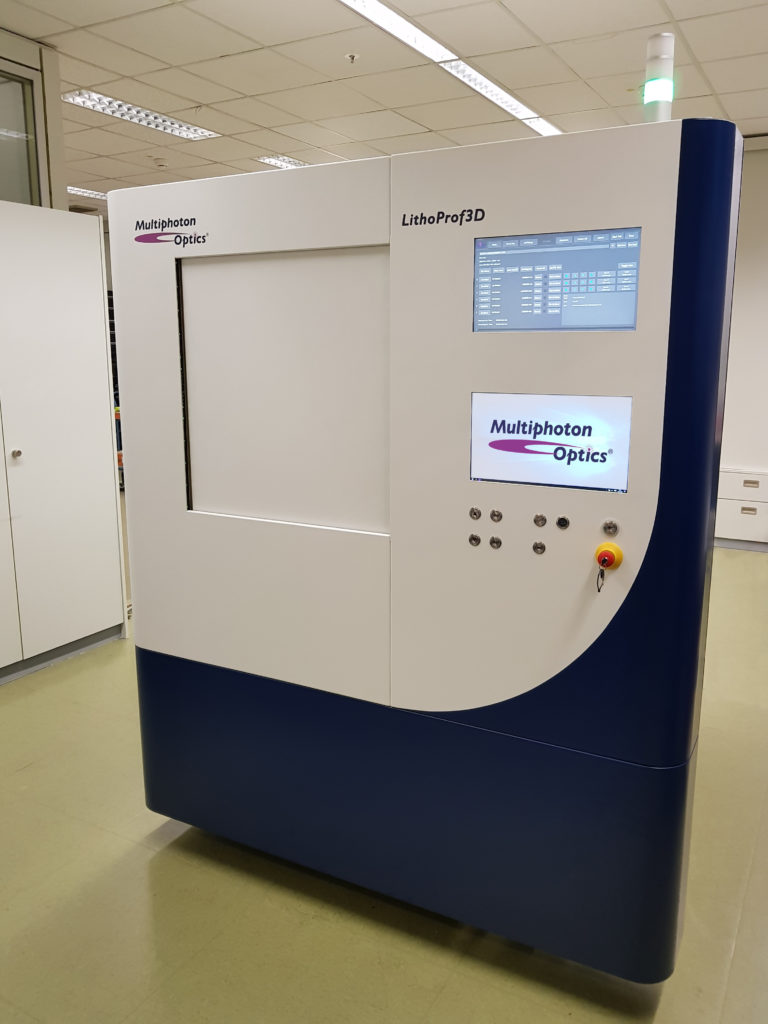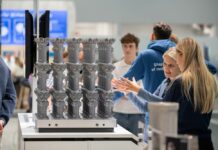Physicist by training, Ruth Houbertz has dedicated her life to building equipment. She is part of the EPIC (European Photonics Industry Consortium) and is certainly one of the 4 female CEOs that everybody who is looking for a career in photonics needs to know. A few minutes with her will enable you to discover a brilliant woman that knows how to make complex concepts easy to understand for everyone. Anyway, that’s what she did in this #OpinionoftheWeek to explain what led to the creation of Multiphoton and how the company distinguished itself from others of the same range in High Precision 3D Printing.
One key element of this interview is photonics. This technology generates and harnesses light and other forms of radiant energy whose quantum unit is the photon.
What led to the creation of Multiphoton Optics?
“I wanted to revolutionize optical data transfer. On the other hand, we identified many different applications and markets in optics and photonics.”
The whole experience has started by late 2000. Ruth was working at Fraunhofer ISC in materials and technology development. The beginnings of the technology were done with LZH. In the course of her works, she aimed at building equipment that would revolutionize the photonics industry and would enable a wide range of new applications. Finding the right person to help her build the desired equipment was not an easy task. That’s how she turned to 3D printing and explored the possibilities offered by this technology.
Supported by various partners around the world, her fascination for 3D Printing led her to explore the technology’s principle with other fields of activities such as semiconductor and optical interconnects. From one experience to another, she then came up with 3D lithography which is now High Precision 3D printing, a technology that enables to create photonics and optical interconnects.
“Simply put, several things led to the creation of Multiphoton Optics: the fascination for 3D Printing and its ability to print any design, my collaborations with semiconductor companies, photonics institutes and optical interconnects specialists. One specific reason that explained the confidence I have in this industry is this simple analysis from another sector: when we looked at telecommunications, it became very clear to me, that the increasing amount of data transferred via internet, would lead to a crucial challenge: energy consumption. It then became obvious to me that we needed much data transfer possibilities in order to lower energy consumption and to protect our environment. In this specific case, we are talking about optical data transfer. Today, with the technological advancements, we can actually reduce the energy consumption for transfer builds. Another reason is that using photonics for production enables to obtain a powerful tool that will serve various industries.”
After several researches and after overcoming various challenges, Multiphoton Optics (MPO) GmbH was officially founded in 2013. As Houbertz stated, speaking of the company’s services: “We sell equipment, but most of the job remains license. We focus on applications & services. We have a real industry 4.0. approach.”
What are the sectors of activity where high precision 3D Printing can be applied?
“We target any industry that uses photonics components which can be produced with our machine”, said the Founder and CEO. In other terms, the possibilities are endless since photonics involve the use of lasers, optics, fiber-optics, and electro-optical devices in a wide range of technical fields including manufacturing, healthcare, telecommunications, environmental monitoring, homeland security, aerospace, solid state lighting, and many more.
Furthermore, “we are currently living in a total accessible market that is worth 2 hundred billion dollars and we can expect further expansion”, explained R. Houbertz.
There is a growing number of companies that start specializing in High Precision 3D Printing. How do you perceive it?
“The more advanced the technology is, the more we will see competitors in the industry. This growing number of competitors just confirmed my idea that we are on the right track. Besides, I strongly believe that competitors enable us to push our limits in order to provide the market with the best technology and with the most sophisticated solutions. I have already had a few exchanges with some competitors and sometimes, it’s really healthy.”
LithoProf3D® provides a platform that integrates both, an additive fabrication mode and a subtractive fabrication mode. How is it possible? Is it possible to use both processes at the same time?

First, it should be noted that High Precision 3D Printing on a sub-micrometer scale enables the creation of structures in an additive process using materials such as photosensitive polymers and hybrid polymers. In a subtractive way, special glasses and metals can be used.
The type of materials used will determine the type of manufacturing process in which the machine will operate: be it additive manufacturing, subtractive manufacturing or another process.
“Both processes cannot operate at the same time because there is only one light source. In order to use both processes at the same time, we would need to integrate another light source”, adds Houbertz.
How do you explain the gap between 3D printing, micro/nano technology and classical fabrication of optics?
“There is still a gap but we will close it. We will do even better. We are basically bridging the gap between micro/nano technology, 3D Printing and injection moulding, because Multiphoton Optics’ technology enables to overcome obstacles in design and manufacture of components. Its name is the program.”
You recently closed a Series B Financing round. Could you share further details about what’s next?
“We have recently achieved a milestone in our activities. Multiphoton Optics has improved the fabrication speed of 3D structures by implementing massive parallel fabrication. Together with 12 partners in 5 different countries, our main goal was to bring 2D and 3D printing to a new level. To achieve this objective, Multiphoton Optics has demonstrated – using a specially designed optics from IMT Atlantique – that its newest model of the LithoProf3D®-GSII series, the LithoProf3D®-GSIIP, is capable of 3D printing 121 structures of 4 µm x 4 µm x 12 µm in just 70 seconds with high quality. Compared to serial fabrication, one would need 2.5 hours for the same amount of structures in this special setup.”
Any last words to add?
“High Precision 3D Printing will rock the world.”
You can now post free of charge job opportunities in the AM Industry on 3D ADEPT Media.
For further information about 3D Printing, follow us on our social networks and subscribe to our newsletter : Facebook, Twitter, LinkedIn & Instagram !
Would you like to be featured in the next issue of our digital magazine? Send us an email at contact@3dadept.com
https://pagead2.googlesyndication.com/pagead/js/adsbygoogle.js
(adsbygoogle = window.adsbygoogle || []).push({});





